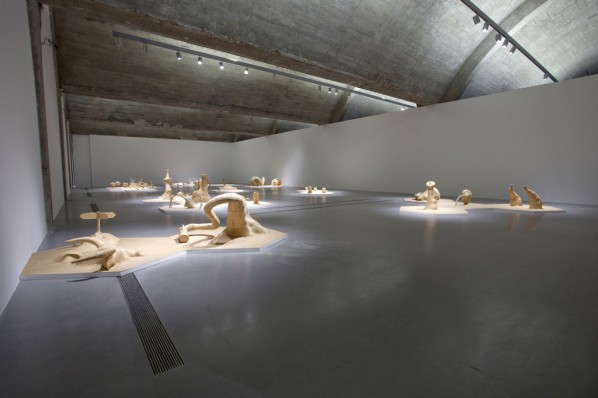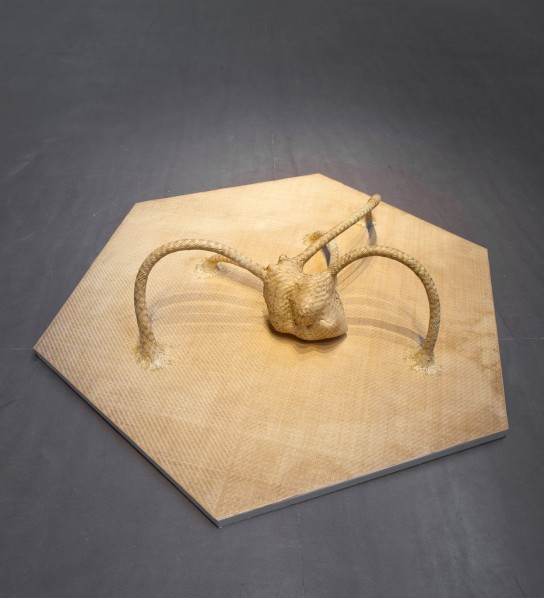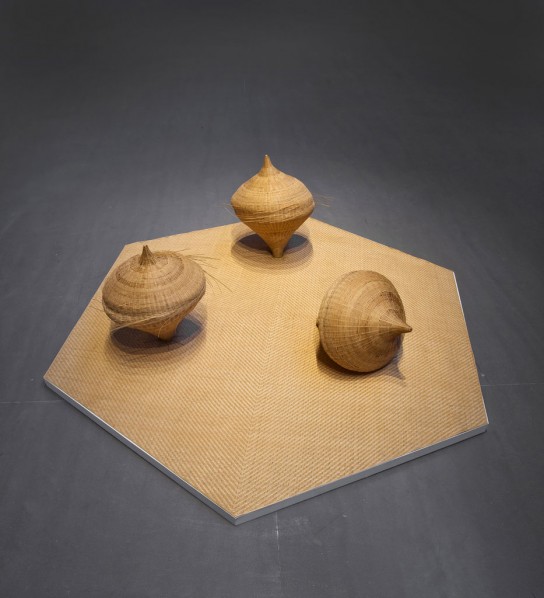
Installation view of "Qiu Zhijie: Cell" at Pace Gallery, Beijing, 2011; Photograph by Wang Xiang, Courtesy of the artist and Pace Gallery, Beijing
The bamboo structures may not look it, but for the artist they represent the intransigence and impermanence of modern China – and his anger at those who seek to portray other, "totalitarian" visions of its people.
Beijing's Pace Gallery Cell exhibition displays 40 bamboo embroidery artworks by Qiu Zhijie, 43, who claims the simple medium reflects the quintessential characteristics of Chinese people.
A graduate of the print department of the China Academy of Art in Hangzhou, Zhejiang Province, in 1992, Qiu's art combines a wide range of media, including photography, video, calligraphy, painting, installation and performance; his works possess an undeniable experimental spirit.
This exhibit showcases "soft" sculpture, namely, the art of fibers, said Qiu. "I'd like to investigate Chinese lifestyle, which seems to be fixed and impossible to be changed. Yet, it is actually ever-changing. My artworks unravel this fact."
The bamboo strands, at first, form honeycomb-like units, which are the base of every sculpture, and then gradually rise from the foundation to shape miscellaneous images, such as hands, hearts, bodies and twigs.

Nirvana by Qiu Zhijie, 2011; Photograph by Wang Xiang, Courtesy of the artist and Pace Gallery, Beijing
As an artist, Qiu has his own peculiar viewpoints about modern society. "I consider that art should be well correlated with true life," he noted. "Chinese people are peaceful, merciful and pliable, like bamboo. Lao Tzu said that supreme benignity is like water, which is exactly what I want to express."
What Qiu observes from his daily life and historic events is, however, somewhat negative. Qiu divided China's recent history into two parts: from 1949 to 1979, and from the Deng years till now. "The keyword of the previous 30 years was 'Revolution,' while, in the latter 30 years, it has become 'Success;' a prevalent ideology around the world, not only in China. Yet, in terms of special historical background, Chinese people are much more eager for success."
"In early 20th century, if there weren't heavyweight figures like Sun Yat-sen or Mao Zedong, China may have been not only invaded by the Japanese but split into several different countries," Qiu said. "The humiliation of nationalism has penetrated into Chinese people's subconscious."

The Heart by Qiu Zhijie, 2011; Photograph by Wang Xiang, Courtesy of the artist and Pace Gallery, Beijing
Qiu described the phenomena of nationalism to be as a mental epidemic, the symptoms of which are to pursue favorable outcomes as soon as possible, or to erect as many monuments as quickly as possible. "[Whether] building China's high-speed railways or the construction of the Bird's Nest... all strive crazily for speedy completion of the projects."
Several installations in public spaces represent these ideas of union, heading towards a future, incubation, or sublimation, Qiu said.
"These public artworks signify an expectation towards the future. Influenced by Western values, Chinese people gradually believe in the possible improvement in the future rather than looking back to the past and tradition."
The outcome is obvious, especially when the Wenzhou bullet-train crash happened last month. "The implicit slogan of modern people seems to be 'taller, faster, stronger,' but I think it should have been 'tall enough, fast enough and strong enough.'"
It becomes a contradictory mindset for the common Chinese people, angry at the government but simultaneously proud of unprecedented achievements. "When unreasonable demolition takes place, the Chinese get furious. On the contrary, when a Chinese-made satellite launched, they feel so proud of their homeland, not to mention the 2008 Beijing Olympics."

Wildfire by Qiu Zhijie, 2011; Photograph by Wang Xiang, Courtesy of the artist and Pace Gallery, Beijing
Qiu strongly opposed director Zhang Yimo's opening ceremony at the Olympics: "It is definitely not an accurate image of common Chinese people." He sarcastically describes the 2008 drummers as "Terracotta Warriors."
"It's an aesthetic belonging to totalitarianism! It's not Chinese at all. Moreover, what the hell is the meaning of group aerobics? Is this North Korea or something? You know what: I think that the identity of every participating performer was diminished to just one pixel," Qiu said. "If the US boycotted Chinese goods once again [as they did in 1989], it would have been because of Zhang's weird aesthetics, and the Publicity Department of the Communist Party should have arrested Zhang," Qiu joked.

Three Situations of the Revolution by Qiu Zhijie, 2011; Photograph by Wang Xiang, Courtesy of the artist and Pace Gallery, Beijing
Most Chinese and foreigners seemed to disagree, finding Zhang's design spectacular. But perhaps they were missing the point. "The real impressions of Chinese people exist in suburban areas, villages or even abroad, where they make a living by themselves. Very diligent, prudent and frugal."
In Qiu's artworks, he expresses an inclination towards artworks of impermanence, decaying, yet alive.
"I weaved the bamboo strands with country women and retired old men from villages in Anhui and Zhejiang Province. We chatted with each other and weaved together," Qiu said – both of his hands are callused. "These are my opposition to monuments or 'bigger Chinese aircraft carriers' phenomena. My ultimate expression, in this exhibition, is a benign circle of life."
About the Writer
Lin Kan Hsuan (Celine Kan-hsuan Lin) is a journalist and editor who now lives and works in Beijing. She has written in-depth reports about exhibitions and artists for Global Times( China) since 2010. Also she has proofread and translated articles for Landmark English Magazine, American Magazine Center in 2009.
For more information, please contact 28start@gmail.com
The views expressed in this column are the author’s own and do not represent those of CAFA ART INFO.




























